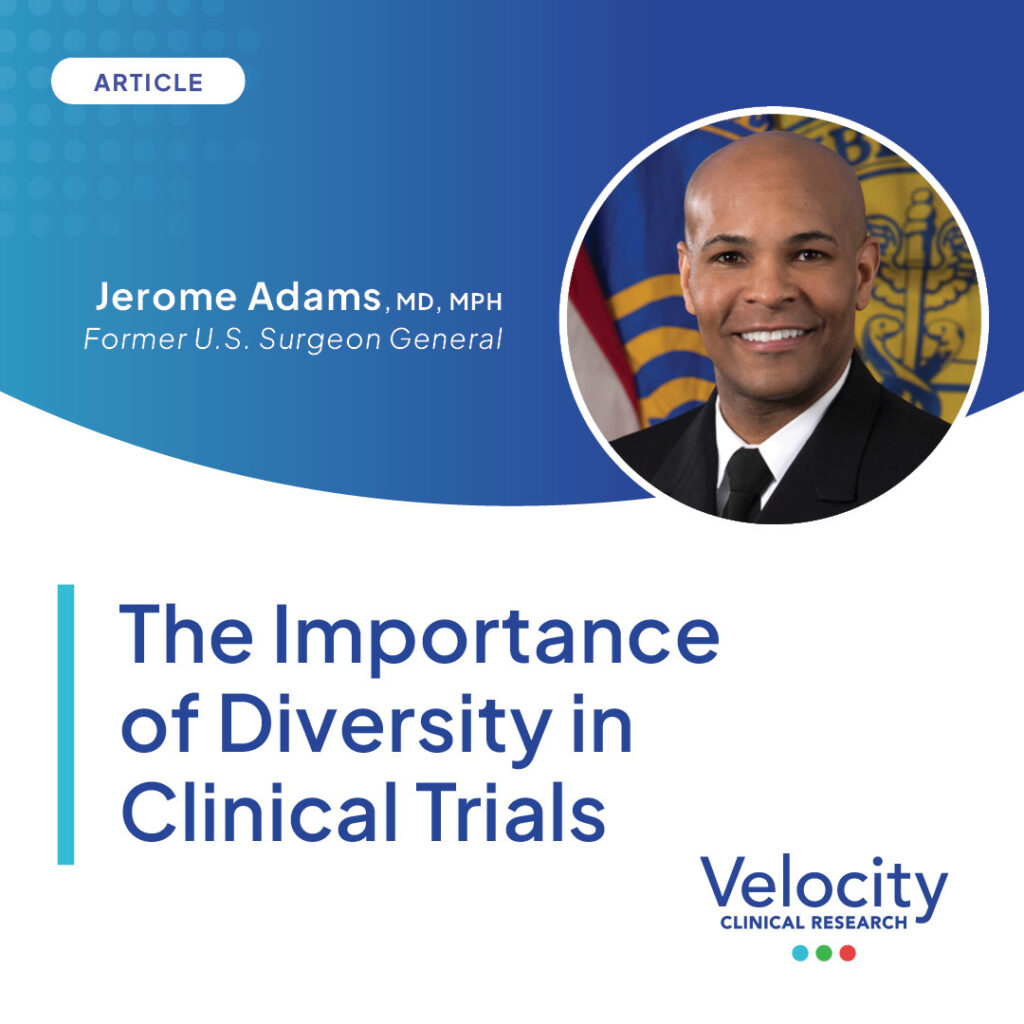The Velocity team had the honor of hosting former U.S. Surgeon General and Chairman of the Board of TOTAL Diversity Clinical Trial Management, Jerome Adams, MD, MPH. He joined an internal call to discuss the importance of diversity in clinical research, highlighting the need for diverse patient populations in clinical trials to ensure new treatments are safe and effective.
Dr. Adams kicked off the discussion by recounting his own story of a severe childhood asthma attack. The incident highlights the inequality still faced by minority communities in the US today. “We know that black Americans are two times as likely to have hospital stays for asthma,” Dr. Adams explained. “They are three times as likely to die and five times as likely to visit the emergency department. What’s interesting is, why does that burden exist in our country and beyond?”
Dr. Adams attributes this to multiple factors, including living conditions, air quality, and inequality in diagnosis. For example, pulse oximeters were developed for light-skinned populations and often provide inaccurate measurements for darker-skinned patients, leading to misdiagnoses.
“There could have been many times when I was younger where I was misdiagnosed and sent home,” He said, “Pulmonary function tests have bias baked into them. Even today, the software uses algorithms and equations that are outdated and give readings that often prevent black men from qualifying for treatment.”
The intersection between economics and health
Why does that matter at a national level? Because economics and health are intertwined. “This isn’t just a sad story for me. It highlights the economic impact of poor health,” Dr. Adams continued, “My parents didn’t pay cash for my helicopter visit to the Children’s Hospital, everyone did through higher insurance premiums and taxes. When I was in the hospital, my mother didn’t work.”
“Many of you have been to a restaurant lately where you got terrible service because there’s one server trying to take care of too many tables. Absenteeism matters when people miss work because they or their family members are sick. My father wasn’t as attentive at work when I was in the hospital. That’s a concept called presenteeism, which impacted his productivity.”
Dr. Adams also noted that had the worst happened, the economic impact would have been lasting. “If I didn’t grow up, I couldn’t participate in the future workforce. Today’s eighth grader is a potential part of the workforce of 2028, so it matters if we don’t have people around because they died early of asthma or because they’re on disability, and a lot of that links back to lack of participation in clinical trials.”
Nadege Gunn, MD, CPI, a Velocity Principal Investigator in Waco, TX, discussed a lack of inclusion in clinical trials and the resulting healthcare disadvantages in a recent article on breaking weight-based stigma in clinical trials. Like Dr. Adams, Dr. Gunn advocates for actively engaging underrepresented communities to educate them on clinical trials, which presents an important opportunity to improve the healthcare available to marginalized communities.
Dr. Adams pointed out, “It’s important to understand that the lack of including people in clinical trials — and the lack of understanding how different diseases, pathologies, and diagnostics play out in different populations — leads to negative outcomes and further healthcare disparities.”
Increasing equity in healthcare
The former U.S. Surgeon General also highlighted the differences between healthcare equity and health equity. The former focuses on differences within patient populations in a hospital or clinical environment — a small part of the bigger picture — while the latter is focused on what is happening in communities, a major contributor to overall health.
“90 cents of every dollar in the United States that goes towards health is spent on clinical care — hospitals and clinics.” He explained, “This is also the main focus in the clinical research world. However, that’s only 20% of what determines our overall health. The rest of our health is determined by health behaviors, social and economic factors and physical environment.”
“The United States has a life expectancy that is five to 10 years below comparable countries. Yet, healthcare spending per capita is at least twice as much as them. In other words, the U.S. health disadvantage is simply that we’re spending more and getting less for our healthcare dollars compared to every other nation out there.”
And a healthier state has economic benefits. Dr. Adams continued, “In a healthier state, it’s easier to recruit workers, communities are more attractive for businesses to locate to, and we have reduced health care costs for businesses and improved worker productivity.”
Shifting the paradigm
Throughout his presentation, Dr. Adams made the case that we need to pay attention to health equity if we want to increase diversity in clinical trials. “Many of the exclusion criteria for clinical trials, such as obesity, smoking, drinking or drug use, all have an impact on people’s ability to participate in clinical trials.”
He highlighted that this is based on outdated theory and the need to move away from that thinking. “We were taught in Science 101 that a clinical trial should eliminate all variability; you want to get everyone as similar as possible to get the results as quickly as possible. We’re in an era now of precision medicine and understand that not everyone works the same or that every drug is going to work the same.” In other words, it’s going to take a paradigm shift away from what many in the industry learned about science and experimentation to get to a place where trials are representative and healthcare is fair and equitable.
The responsibility of clinical trials
As U.S. Surgeon General, Dr. Adams helped propel clinical trials — and specifically the importance of diversity in clinical trials — to the top of the national agenda. He served as the nation’s doctor during the unprecedented COVID-19 pandemic and was part of the team charged with delivering Operation Warp Speed, a fast-tracked vaccine.
“We had three different candidates for a vaccine in under a year,” he explained, “But on starting the project, the first question I asked was, what does the trial enrollment look like?”
Through experiences within his own community, which has reason to distrust healthcare practitioners following incidents like the Tuskegee study, Dr. Adams was acutely aware that a lack of representation in the trial environment would prevent the uptake of any eventual vaccine among minority populations. Many of these minorities were at higher risk from the COVID-19 virus as a result of health inequity.
“We had a real ethical dilemma,” he explained, “Trial participation was at single digits in some cases. We had to choose between slowing these trials down to increase diversity, knowing that could cost lives, or forge ahead and get these products across the finish line. But, if we forged ahead, we’d then have to go to the communities that are most impacted and say well, we don’t actually really know whether or not this is going to work in your community, whether or not this is safe in your community, because we didn’t test it on you.”
The solution was a weekly call with Francis Collin, NIH Director, Anthony Fauci, then Chief Medical Advisor to the President, and Dr. Adams. The trio hosted every major drug company every Saturday morning and helped them develop plans to increase diversity in their clinical trials. “And I’m proud to say that all of them significantly increased their diversity in clinical trials in just a few months.”
Dr. Adams noted proudly, “We’d been talking about increasing representation for decades — literally decades — but it had been mostly all talk and no walk. Operation Warp Speed showed that it could be done.”
It’s an example the current administration has been keen to follow. “While that happened under the Trump administration,” explains Dr. Adams, “The Biden administration, after seeing the diversity in clinical trials that occurred during Operation Warp Speed, started holding people’s feet to the fire.” In January 2024, the Food and Drugs Administration (FDA) proposed a new standard for collecting race and ethnicity data; it requires sponsors to tabulate an annual report of the number of participants enrolled in a clinical trial by certain demographic subgroups, including race.
“It was always assumed you had to pick one or the other in clinical trials; speed or diversity,” explained Dr. Adams, “To me, that is a false narrative. If you wait until the end to think about diversity then yes, it will slow you down. But what we showed with Warp Speed, which was the largest clinical trial in history, is that even if you come in midway and make a concerted effort, you can get there without slowing down the trials.”
When asked by the Velocity team about what lessons he’d learned during the process, Dr. Adams highlighted the importance of representation within the clinical trials environment, as well.
The team needed to increase diversity in trials during Warp Speed and assumed that trial sites in Atlanta, which has the highest concentration of African Americans in the country, would be the best place to enroll these communities. “Everyone assumed that this site in Atlanta would be great at enrolling in clinical trials, and it was terrible,” Dr. Adams recounted, “And then we looked at a site in Iowa, and it was one of our highest enrolling diverse sites. If you just go in with the assumption that putting a trial in a Black community or a brown community is going to increase your enrollment without understanding the ingredients that it takes to have people participate, then you’re going to fail. And if you also assume that you can’t get great enrollment at sites that aren’t in high-concentration environments, then you’re also wrong.”
So, what are some of those ingredients? “We found that you need diversity within your organization. The Principal Investigator matters, and the person at the front desk matters. Patients trust clinical trials staff that speak their language and have similar lived experiences.”
Playing politics with health
Halfway through the biggest election year in history, politics was bound to play a part in the conversation, and Dr. Adams was happy to share his take, “Going into this election, I think it is important that we try to recognize when people are feeding us political lines, and that we recognize our own bias — which we all carry.”
He went on to discuss a specific example, “I’ve been asked whether I support Obamacare. And what’s interesting about that question is the phrase, Obamacare. Obama was the Democratic President of the United States. That question alone is politically loaded, and people don’t understand that when you ask that question, you’re automatically taking it to a political place instead of a medical one. Either answer is a political answer. The medical answer, my answer as a physician, is that I believe everyone should have access to high-quality, affordable health care, and I’m willing to work with any administration seeking to achieve that goal.”
“We have to understand that other people’s politics have the potential to bias healthcare. And we have to treat people with respect. And I think that’s a great note to end on. If you treat each other respectfully, you’ll see more of that. If you treat each other with disrespect, then you’re going to see more of that out there.”

